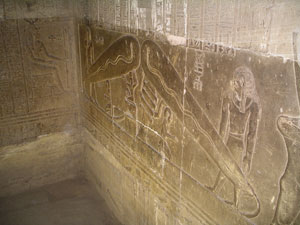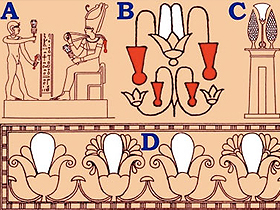The discovery of various wall carvings or friezes discovered in the Hathor Temple of Dendera Temple Complex in Egypt has revealed one especially fascinating piece of information about the ancient Egyptians. A large part of the friezes, examined below, are in the Dendera Temple Complex. These show that the ancient Egyptians obtained lighting by using bulbs and the arc light technique.
Close inspection of these pictures in the Temple of Hathor shows that high-voltage insulation was used, just like that of today; this is supported by a rectangular column resembling a light bulb (believed to have been used as an insulator and known as the Djed Column.) This astonishing resemblance to the light bulbs we use today is most striking.
 |  |
 | The Austrian electrical engineer Walter Garn studied the friezes in great detail, and reproduced the Djed Column insulator, bulb and twisting wire. The model he built did indeed work and emit light. |
In a documentary broadcast in September 1996 by the American ABC channel, this lighting system was tested by scientists before the cameras. Success was once again achieved and light obtained. This is basically a light bulb and it worked through the technique shown in the ancient Egyptian wall paintings, thus providing light. In the video that follows you can see how light is obtained through the methods employed by the ancient Egyptians.
 |
| In this painting from the Dendera Temple, four wide filament (the component in lamps that permits heating) lamps can be seen on the left. A cable stretching from a giant electric battery on the left powers these lamps. |
 |
 | Close examination of the picture above shows that the electric cables joining the battery to the lamp are covered in tiny beads set out in sequence. Beads like this are used to insulate the electricity coming from the cable. The picture below shows one of the arc lamps first manufactured in the 19th century. |
Lighting in ancient Egypt was provided using the classic bulbs we employ today. The Egyptian pictures show bulb-like devices with filament wires, a holder and current wires. In the picture below, the person is reading picture texts on the wall by lighting the surrounding area with the lamp in his hand.

 | The first filament lamp, invented by Thomas Edison and shown in the picture, bears a close resemblance to the lamps being held by the Egyptians. |
 | In this picture discovered on a tomb wall in the Dendera Temple, an electric cable is leading away from a lamp with three bulbs. |
 | This picture shows a battery and cable in one of the figure’s hands and an electric lamp in the others’. |
 |
This illustration tells us about the lighting plan in the Dendera Temple.Section B shows that red-colored batteries are attached to white electric lamps. |
One piece of evidence that Ancient Egyptians may have used electricity is the absence of any traces of soot on the interior walls of their tombs and pyramids. If—as evolutionist archaeologists maintain—they used burning torches and oil lamps for lighting, then traces of soot would inevitably have been left behind. Yet there are no such traces anywhere, not even in the very deepest chambers. It would have been impossible for construction to continue without the necessary lighting being provided nor, even more importantly, for the magnificent murals to have been painted on the walls. This strengthens the possibility that electricity was, indeed, used in Ancient Egypt.
 |
| The Djed Column, frequently encountered in Egyptian hieroglyphics, may symbolize such electrical equipment. The Djed Column may serve as a generator for light to be provided in this way. |
In arc lamps, lighting is provided as a result of a light arc arising between two conductor rods. When the two rods with opposite charges are touched against one another and then held a few millimeters apart, the current that arises causes light to be emitted. Arc lamps are 200 times more powerful than classic bulbs and emit a very strong, bright light. Due to their power, these bulbs are used in studios, light therapy, projector lamps and cinematography.

 In this illustration, two opposite charged metallic items held by the person on the right and left are shedding light by setting up an electric current. | ||
 The reconstruction on the left shows how the arc lamps in the Dendera Temple were used. On the right is a light arc set up with two opposite charged carbon rods. | .jpg) | |

A bulb working on the arc lamp principle that provides
very powerful lighting in present-day projectors
and as used also by the ancient Egyptians.

charged carbon rods using electricity from a car battery.
The lights held by the ancient Egyptians also resemble small
torches with their own batteries underneath them.
Contrary to what evolutionists claim, the history of mankind is full of proofs that ancient peoples possessed far superior technologies and civilizations than had been believed. One of these proofs is the Ancient Egyptians’ knowledge of electricity.


